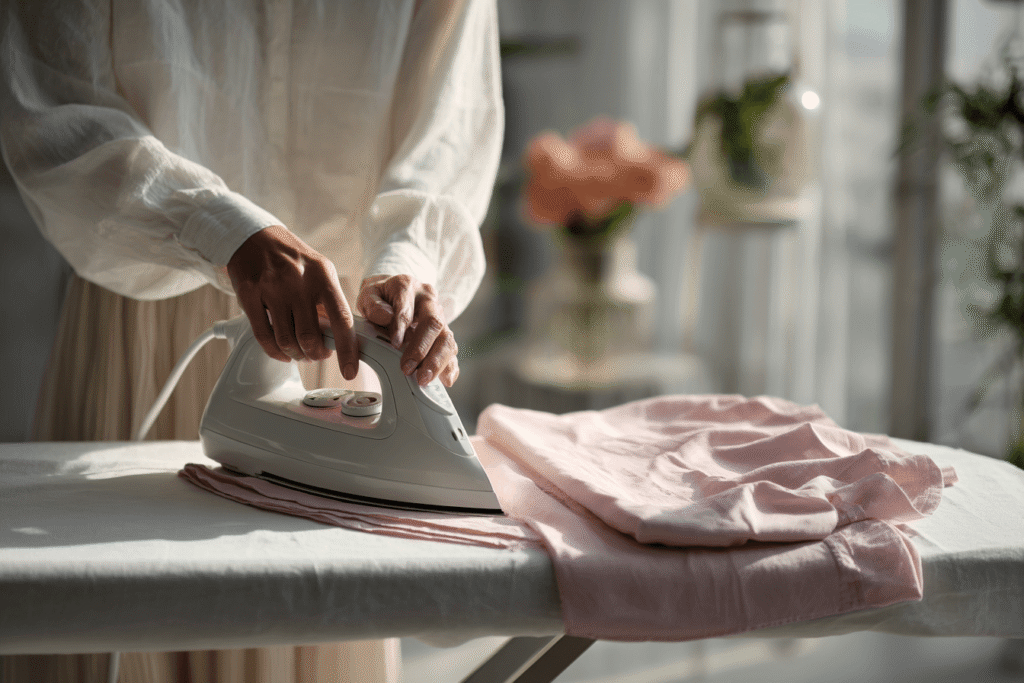Summarise this article with:
Fancy keeping your delicate fabrics looking fresh without the fear of heat damage? We get it – that gorgeous silk blouse or delicate wool jumper deserves the gentle treatment. Cold ironing is your fabric-friendly solution, using low temperatures (typically 110°C or below) to smooth out wrinkles whilst protecting sensitive materials from scorching or melting.

What is Cold Ironing? Temperature and Fabric Basics
Cold ironing uses lower temperatures (below 110°C) to protect delicate fabrics from heat damage. Different materials need specific temperature ranges to avoid melting, scorching, or creating unwanted shine marks.
| Fabric Type | Temperature Range | Notes |
|---|---|---|
| Polyester & Synthetic Blends | 90-110°C | Use pressing cloth, iron inside out |
| Nylon | 80-100°C | Lowest setting, avoid steam |
| Cotton (lightweight) | 150-180°C | Medium heat, can use steam |
| Wool | 110-150°C | Use pressing cloth, avoid direct contact |
Pro Tip: Start with the coolest setting and gradually increase if needed. You can always add more heat, but you can’t undo fabric damage!
Understanding these general guidelines helps you achieve better results whilst protecting your dress shirts and delicates from permanent damage.
How Do You Cold Iron Clothes Step-by-Step?
Setting Up Your Iron for Beginners
Getting your workspace ready makes all the difference for successful cold ironing. Here’s what you need to sort before you start:
- Choose a stable ironing board or create a flat surface using a stack of towels on a table
- Fill your iron’s water reservoir with distilled water to prevent mineral buildup
- Check the care instructions on your garment’s label first
- Set your iron to the lowest hot setting suitable for your fabric type
- Allow 5-10 minutes for your iron to reach the correct temperature
Top Tip: People often rush this setup, but taking these few minutes gives you better rest between garments and tackles stubborn wrinkles more effectively.
Position your garment flat without stretching the fabric. This preparation prevents creasing and ensures even heat distribution across delicate materials for professional-looking results every time.
Cold Iron Technique for Pants and Delicates
Turn your garment inside out to protect the fabric surface from direct heat contact. This simple step prevents shine marks on wool and synthetic materials.
Use a pressing cloth between your iron and delicate fabrics. A clean cotton tea towel works brilliantly for this purpose. Move the iron smoothly rather than pressing down heavily – gentle gliding motions work best for removing creases without damaging fibres.
For trousers, start with the waistband and work your way down each leg systematically. Good idea: fold along existing creases to maintain sharp lines, then press lightly to set them in place.
Remember to keep your iron moving constantly – lingering in one spot for too long can leave permanent marks on sensitive materials.
Can Steam Cool Iron Work Better Than Heat?
Steam vs Cold Iron: When to Use Each Method
Steam irons work brilliantly for cotton and linen garments that need crisp, sharp creases. The moisture helps relax fibres whilst the heat sets professional-looking lines. Perfect for dress shirts and formal trousers.
Cold iron methods suit delicate materials like polyester, nylon, and synthetic blends that can’t handle high temperatures. You’ll get better results without risking fabric damage or unwanted shine marks.
- Choose steam when you need structured, crisp finishes on sturdy fabrics
- Go cold for quick touch-ups on heat-sensitive materials
- Combine both methods for mixed-fabric garments by tackling different sections appropriately
Top Tip
Check fabric composition first — blended materials often need the gentler cold approach to protect the most sensitive fibres in the mix.
Cold Iron Spray Solutions for Quick Touch-Ups
Cold iron sprays offer a brilliant alternative when you’re short on time or dealing with delicate fabrics that can’t handle traditional heat. These plant-based solutions work by relaxing fabric fibres, letting gravity do the heavy lifting.
How to use them effectively:
- Hang your garment on a sturdy hanger first
- Spray evenly from about 30cm away, covering both sides
- Smooth the fabric gently with your hands
- Allow 5-10 minutes for complete drying
Pro Tip: These sprays work best on natural fabrics like cotton and linen, but avoid using them on 100% polyester materials where they’re less effective.
For a completely hassle-free approach to garment care, our professional ironing services can handle everything from delicate silk blouses to stubborn cotton shirts, saving you time for the things that matter most.
Professional Cold Ironing Services and Alternatives
Struggling with that pile of delicate garments? Professional services can handle your cold ironing needs whilst you focus on what matters most.
| Option | Best For | Time Needed |
|---|---|---|
| Professional ironing services | Delicate fabrics, formal wear | Same-day pickup |
| Handheld steamers | Quick touch-ups, travel | 2-3 minutes |
| Wrinkle-release sprays | Light creases, synthetic fabrics | 10 minutes drying |
Why choose professional services? They use specialised equipment and techniques that protect your most precious garments. Our Wecasa cleaning professionals handle everything from silk blouses to wool suits with expert care.
Top Tip
Combine professional services for special occasions with home alternatives for daily maintenance — you’ll save money whilst keeping your wardrobe looking sharp year-round.













